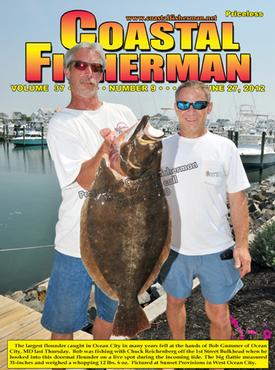


Article by Capt. Mark Sampson
 Last week I wrote about how anglers can interpret and use the local marine forecasts to help ensure a safe and pleasurable offshore boating experience. But as important as it is to know what the “predictions” are for the day’s weather, it’s just as important to know what’s actually happening out there. After all, a forecast is merely an educated “guess” of what “should” happen, and as we all know, Mother Nature isn’t always as predictable as we would like. No doubt that I’m not the only one who has had trouble standing on a pitching and rolling deck on a day the weatherman said it was supposed to be flat-calm, or didn’t set my alarm because it was supposed to be rough tomorrow but awoke to a morning with no wind. Weather reporting is good these days - but it’s not perfect!
Last week I wrote about how anglers can interpret and use the local marine forecasts to help ensure a safe and pleasurable offshore boating experience. But as important as it is to know what the “predictions” are for the day’s weather, it’s just as important to know what’s actually happening out there. After all, a forecast is merely an educated “guess” of what “should” happen, and as we all know, Mother Nature isn’t always as predictable as we would like. No doubt that I’m not the only one who has had trouble standing on a pitching and rolling deck on a day the weatherman said it was supposed to be flat-calm, or didn’t set my alarm because it was supposed to be rough tomorrow but awoke to a morning with no wind. Weather reporting is good these days - but it’s not perfect!
In a perfect world, all offshore anglers would have a friend out on the ocean 24-hours a day who could give actual unbiased reports of weather and sea conditions anytime they’re needed. Unlike a “forecast”, our friend wouldn’t be telling us what it’s “supposed” to be like, he’d be able to tell us what it really “is” like right then and there and would also be happy to relay accurate details about how conditions were every hour for the last 24-hours. Such a friend would allow us the opportunity to compare “fact” from “prediction” and give us a better opportunity to make the right decision to go fishing or stay at the dock.
The good news is that we all have such a friend, and he’s out there right now bobbing around about 15-miles offshore just waiting for us to call him up and get the report. He can tell you the average wind speed, maximum gusts, wave heights, average and dominate wave periods, water and air temperatures. Besides letting us know where the fish are, I don’t know what else our friend could tell us!
In this case our friend, is none other than a big yellow buoy named “Station 44009” floating at about 15- miles off the Maryland-Delaware line at 38°27 N and 74°42 W. Affectionately known by more veteran anglers as the “Delaware Light,” Station 44009 is a part of NOAA’s National Buoy Data Center and is one of a series of floating, unmanned weather reporting stations located around the world.
By logging on to http://www.ndbc.noaa.gov/station_page.php?station=44009 boaters can access the Delaware Light site and get a wealth of information that could help to confirm or contradict what the weatherman says should be happening out there anytime day or night. A condensed version of the weather details is also periodically broadcast over the VHF-radio weather channels, but seeing it online is really the best way to go as it provides the most current and historical information.
As I write this, it’s a very breezy Saturday morning and looking at the buoy report I see that the wind is Northeast at 40-degrees true and it’s blowing 17.5 knots with gusts to 19.4 knots – that’s pretty windy! I also see that the wave heights are averaging 4.9 feet with an average period between waves of 4.8 seconds. Therefore, I know that the waves are tall and close together which makes for a very uncomfortable mix. If the waves were the same height but maybe 9 or more seconds apart, it would indicate that there was just a big swell, but right now she’s tall, steep and not the place I want to be.
The buoy is also reporting a barometric pressure of 30.32 inches and rising, an air temperature of 65.1 degrees (burrrr!) and a water temperature of 67.1 degrees. All that information was taken at 8:50 AM, but I can scroll down and get those readings for every one of the last 24-hours which allows me to see what the trend has been and determine if it is getting rougher or calmer. By comparing what has actually been happening to what the forecast says was supposed to happen, I can decide how much faith to put in the forecast for the rest of the day. For instance, if they’re calling for it to get better as the day goes on but over the last 12-hours it’s only gotten worse, I might want to think twice about scheduling an offshore trip around the predictions. Sometimes it’s really nice to have friend offshore!
Captain Mark Sampson is an outdoor writer and captain of the charter boat “Fish Finder”, docked at the Ocean City Fishing Center.